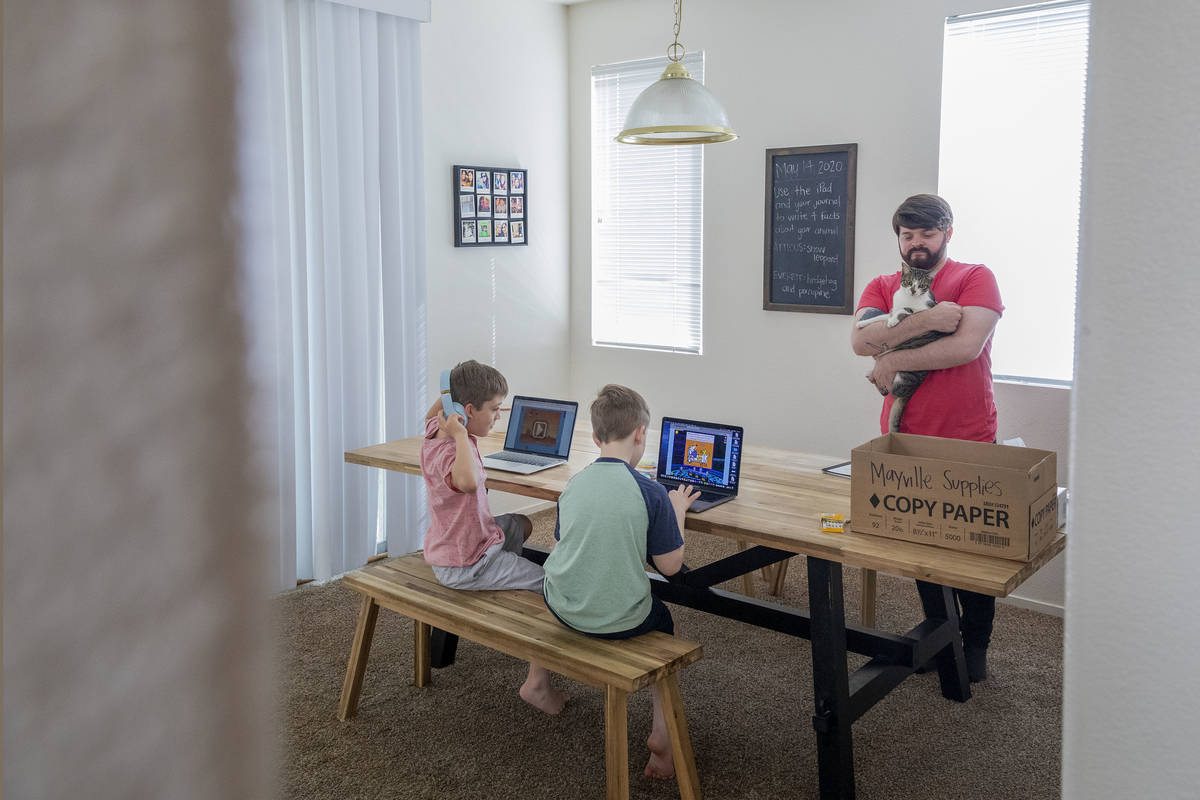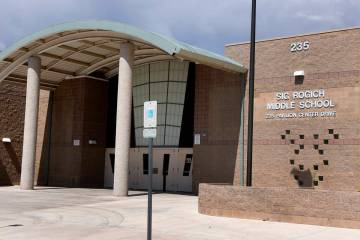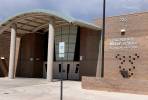Clark County staff, families wonder: Is distance learning sustainable?
With one month of virtual school in the books, Clark County School District staff and families report widely varying experiences with distance learning, but have one unifying question moving forward: How long is this system sustainable for all parties involved?
This conversation in classrooms and boardrooms marks a shift from the initial sprint to get students connected to their virtual classrooms, to the understanding that distance learning is a marathon — here to stay for at least the next two months — that must be workable until then.
“I do worry about the sustainability of this system especially for younger kids who are struggling while they’re staring at screens for long periods of time while they have to be supervised by their parents,” school board President Lola Brooks said at a meeting Thursday. “This is very difficult for young kids.”
“My concern is that we’re having 6- and 7-year-olds literally sit in front of a computer for four to five hours,” said Trustee Chris Garvey. “I hardly know any adults that can do that without getting up to get a cup of coffee … I’m not sure that this is how we’re going to keep families engaged. I keep getting emails from people saying I can’t do this much longer.”
Enrollment and attendance
By the numbers, the school district is reporting more engagement now than during the spring quarter, when up to 100,000 students were out of weekly contact with teachers.
During the first and second weeks of school, the district reported an attendance rate of 88.7 and 90.3 percent, respectively, and has touted the statistic that 99 percent of all students have been marked present at least once since school began.
Furthermore, some 95 percent of students have been contacted about their technology needs, and of those, 95 percent have reported access to devices and 96 percent are connected to the internet, according to a district presentation, with the community partnership Connecting Kids Nevada estimating that 9,317 students are still left to contact.
The work to find the remaining missing students is ongoing, said Punam Mathur, executive director of the Elaine P. Wynn and Family Foundation. It now includes not only door-to-door efforts to find students who have been AWOL, but efforts to assist students who aren’t logging in to the Canvas learning management system consistently — suggesting that their connectivity may not be reliable.
“Even if they’ve figured it out or are doing whatever it takes, if they don’t have reliable connectivity or a device for every child in the house, they ought to,” Mathur said.
Of the still-missing students, Black and Hispanic students are disproportionately represented, according to Connecting Kids. One day’s worth of data showed that Black students represent 15 percent of the district’s total population but 23.8 percent of the number of missing students, Mathur said, while Hispanic students represent 47 percent of the district’s population and 53 percent of uncontacted students.
Poverty and language barriers are two obstacles to engagement, Mathur said, which Connecting Kids is trying to combat by knocking on doors, offering a Spanish-language hotline and broadcasting in community media.
Broadly speaking, Mathur said distance learning is going far better than it did in the spring, particularly with the community buy-in behind the Connecting Kids partnership.
“Nothing is possible in distance learning without connectivity and a device,” Mathur said. “But in and of itself, connectivity and a device does not translate to true engagement.”
In the classroom
Once the technology hurdle is cleared, families characterize distance learning as largely a mixed bag: fine for independent learners but a struggle for younger students, and especially challenging for households managing more than one school schedule.
Teachers, meanwhile, say they’re adapting to the medium, but working late or through the weekend to keep up, juggling lessons for their students and assisting their own children.
Rebecca Dirks Garcia, president of the Nevada PTA and moderator for the CCSD Parents group on Facebook, said one consistent plea from parents since the school year began has been more flexibility in their children’s schedules. While some schools have listened and provided, the accommodations have not been universal, she said.
“While we may be one district, the experience is very different based on which school your child attends. Obviously some families have just left because of these issues and more continue to openly share they are considering unenrolling because the current set-up is not sustainable,” Garcia said. “Sustainable is a word that comes up a lot; it’s clear both teachers and families are exhausted and not sure how many more weeks they will be able to keep up.”
Barbara Vesci said her 11-year-old daughter, who has learning disabilities and epilepsy, has struggled to work on a Chromebook for the requisite six hours every day, coming away with headaches, dizziness and increased seizures. Vesci added that with her own limited tech fluency, she can’t always help her daughter navigate the different programs required in class.
She’s hoping to revise the girl’s Individualized Education Plan to limit screen time, she said, and offer a mix of packet work instead.
“It’s not sustainable. I’m not going to sacrifice her physical and emotional health,” Vesci said. “I don’t want to be crying and fighting with my daughter every day.”
Allysha McLaughlin made a color-coded schedule for her first- and third-grader at the beginning of the year, and says the family has mostly stuck to it. With her older child working independently, she said she’s able to focus on helping her first-grader through virtual lessons.
Paper packets have helped limit screen time, she said, and an incentive at the end of the day like bubbles helps keeps the kids on track to finish their work. There have even been unforeseen benefits, like a family vacation where the kids could keep up with their school work virtually.
“But it takes a toll. Every single day they ask when do we get to go to real school?” she said. “Well for right now, this is real school. For them it’s been difficult on that level.”
Jessica Jones, a kindergarten teacher at Hickey Elementary, said virtual learning is going better for her class, as she finds innovative ways to teach those who are lacking supplies at home. No pencils? No paper? No problem; Jones said she asks students to make letters and numbers out of whatever they have on hand.
But the trade-off is that Jones can’t help her own children with their schoolwork throughout the day, she said. Her middle-schooler is doing very well, she said, while her elementary school-aged daughter struggles to navigate the platform independently. By the time Jones is done with work and able to help, the girl has been on the computer for upwards of five hours, and has a headache — four weeks of which has led to signs of depression and trouble focusing, she said.
“I feel guilty because I cannot help her during the day because I am teaching,” Jones said. “So as awful as it sounds to say this, I feel like I have to pick my class over my own child when it come to this.”
Andrea Roach, a second-grade teacher at Tyrone Thompson Elementary, said she’s worked every weekend since school began to create synchronous and recorded lessons for her classes. While she receives good feedback from families, she said she can’t help but wonder if students are absorbing the material .
Technology has its ups and downs, she said: Spotty connections continue to be a problem, but on the flip side, breakout rooms have offered her students a prized chance to socialize with each other.
“They just don’t get to have that classroom interaction,” she said.
Spring Valley High teacher William Hemberger said he’s trying to find the right balance of assigning too much work and too little, with some students reporting feeling overwhelmed. His own elementary school-aged daughter is doing well academically, he said, but distance learning has sapped some of her motivation to go to school.
One activity that’s worked well during distance learning, he said, is a day dedicated to organization, as well as breakout rooms that allow students a chance to feel normal.
“We’re all trying to do the best we can in this situation,” he said.
What’s ahead
The district has committed to distance learning for the first semester, with regular updates to the school board on COVID-19 data that could impact reopening.
At the first such presentation on Thursday, Southern Nevada Health District Acting Officer Fermin Leguen said while Clark County’s data is trending downward, it still shows a higher risk for reopening schools.
Apart from that health data, trustees said they want to see other information at future meetings, including a request from Trustee Danielle Ford for more information on mental health, what challenges educators are facing and whether it would be possible to bring some students and educators back.
“We’re only above water a little bit because our teachers have figured it out,” Ford said.
Board president Brooks also said the community deserves more information on when schools might reopen, including target health metrics in writing at the next presentation.
“I realize that we’re not ready to open up,” Brooks said. “I think reopening right now, the risk is too high for community spread. But the community does deserve to know when schools might reopen, and what those metrics are for reopening.”
Contact Aleksandra Appleton at 702-383-0218 or aappleton @reviewjournal.com. Follow @aleksappleton on Twitter.
RELATED
Las Vegas Valley private schools report having few COVID cases
Washoe school district sees rocky start to in-person learning
CCSD teachers hitting internet data limits under distance learning

















































